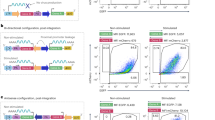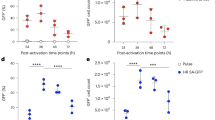Abstract
The clinical application of self-inactivating (SIN) retroviral vectors has been hampered by the lack of reliable and efficient vector production technologies. To enable production of SIN γ-retroviral vectors from stable producer clones, a new PG13-based packaging cell, known as PG368, was developed. Viral vector expression constructs can be reliably inserted at a predefined genomic locus of PG368 packaging cells by an Flp-recombinase-mediated targeted cassette exchange (RMCE) reaction. A new, carefully designed vector-targeting construct, pEMTAR-1, eliminated the co-packaging of the selectable marker gene used for the identification of successful recombination at the predefined genomic locus and thus, improved the safety of the production system. Selected clones produced vector supernatants at consistent titers. The targeted insertion of therapeutically relevant SIN vectors for chronic granulomatous disease and X-linked severe combined immunodeficiency into PG368 cells results in stable titers within the range necessary for clinical application. The production of retroviral SIN vectors from stable clinical-grade producer cells is feasible and will contribute to the safe production and application of SIN γ-retroviral vectors for clinical trials.
This is a preview of subscription content, access via your institution
Access options
Subscribe to this journal
Receive 12 print issues and online access
$259.00 per year
only $21.58 per issue
Buy this article
- Purchase on Springer Link
- Instant access to full article PDF
Prices may be subject to local taxes which are calculated during checkout





Similar content being viewed by others
References
Cavazzana-Calvo M, Thrasher A, Mavilio F . The future of gene therapy. Nature 2004; 427: 779–781.
Hacein-Bey-Abina S, Le Deist F, Carlier F, Bouneaud C, Hue C, De Villartay JP et al. Sustained correction of X-linked severe combined immunodeficiency by ex vivo gene therapy. New Engl J Med 2002; 346: 1185–1193.
Aiuti A, Slavin S, Aker M, Ficara F, Deola S, Mortellaro A et al. Correction of ADA-SCID by stem cell gene therapy combined with nonmyeloablative conditioning. Science 2002; 296: 2410–2413.
Aiuti A, Cattaneo F, Galimberti S, Benninghoff U, Cassani B, Callegaro L et al. Gene therapy for immunodeficiency due to adenosine deaminase deficiency. N Engl J Med 2009; 360: 447–458.
Ott MG, Schmidt M, Schwarzwaelder K, Stein S, Siler U, Koehl U et al. Correction of X-linked chronic granulomatous disease by gene therapy, augmented by insertional activation of MDS1-EVI1, PRDM16 or SETBP1. Nat Med 2006; 12: 401–409.
Hacein-Bey-Abina S, von Kalle C, Schmidt M, Le Deist F, Wulffraat N, McIntyre E et al. A serious adverse event after successful gene therapy for X-linked severe combined immunodeficiency. New Engl J Med 2003; 348: 255–256.
Zychlinski D, Schambach A, Modlich U, Maetzig T, Meyer J, Grassman E et al. Physiological promoters reduce the genotoxic risk of integrating gene vectors. Mol Ther 2008; 16: 718–725.
Montini E, Cesana D, Schmidt M, Sanvito F, Ponzoni M, Bartholomae C et al. Hematopoietic stem cell gene transfer in a tumor-prone mouse model uncovers low genotoxicity of lentiviral vector integration. Nat Biotechnol 2006; 24: 687–696.
Montini E, Cesana D, Schmidt M, Sanvito F, Bartholomae CC, Ranzani M et al. The genotoxic potential of retroviral vectors is strongly modulated by vector design and integration site selection in a mouse model of HSC gene therapy. J Clin Invest 2009; 119: 964–975.
Modlich U, Bohne J, Schmidt M, von Kalle C, Knoss S, Schambach A et al. Cell-culture assays reveal the importance of retroviral vector design for insertional genotoxicity. Blood 2006; 108: 2545–2553.
Dull T, Zufferey R, Kelly M, Mandel RJ, Nguyen M, Trono D et al. A third-generation lentivirus vector with a conditional packaging system. J Virol 1998; 72: 8463–8471.
Negre D, Cosset FL . Vectors derived from simian immunodeficiency virus (SIV). Biochimie 2002; 84: 1161–1171.
Yu SF, von Ruden T, Kantoff PW, Garber C, Seiberg M, Ruther U et al. Self-inactivating retroviral vectors designed for transfer of whole genes into mammalian cells. Proc Natl Acad Sci USA 1986; 83: 3194–3198.
Schambach A, Wodrich H, Hildinger M, Bohne J, Krausslich HG, Baum C . Context dependence of different modules for posttranscriptional enhancement of gene expression from retroviral vectors. Mol Ther 2000; 2: 435–445.
Schambach A, Bohne J, Chandra S, Will E, Margison GP, Williams DA et al. Equal potency of gammaretroviral and lentiviral SIN vectors for expression of O6-methylguanine-DNA methyltransferase in hematopoietic cells. Mol Ther 2006; 13: 391–400.
Schambach A, Swaney WP, Loo JC . Design and production of retro- and lentiviral vectors for gene expression in hematopoietic cells. Methods Mol Biol 2009; 506: 191–205.
Bode J, Schlake T, Iber M, Schubeler D, Seibler J, Snezhkov E et al. The transgeneticist's toolbox: novel methods for the targeted modification of eukaryotic genomes. Biol Chem 2000; 381: 801–813.
Wirth D, Gama-Norton L, Riemer P, Sandhu U, Schucht R, Hauser H . Road to precision: recombinase-based targeting technologies for genome engineering. Curr Opin Biotechnol 2007; 18: 411–419.
Schucht R, Coroadinha AS, Zanta-Boussif MA, Verhoeyen E, Carrondo MJ, Hauser H et al. A new generation of retroviral producer cells: predictable and stable virus production by Flp-mediated site-specific integration of retroviral vectors. Mol Ther 2006; 14: 285–292.
Coroadinha AS, Schucht R, Gama-Norton L, Wirth D, Hauser H, Carrondo MJ . The use of recombinase mediated cassette exchange in retroviral vector producer cell lines: predictability and efficiency by transgene exchange. J Biotechnol 2006; 124: 457–468.
Verhoeyen E, Hauser H, Wirth D . Evaluation of retroviral vector design in defined chromosomal loci by Flp-mediated cassette replacement. Hum Gene Ther 2001; 12: 933–944.
Miller AD, Garcia JV, von Suhr N, Lynch CM, Wilson C, Eiden MV . Construction and properties of retrovirus packaging cells based on gibbon ape leukemia virus. J Virol 1991; 65: 2220–2224.
Gaspar HB, Parsley KL, Howe S, King D, Gilmour KC, Sinclair J et al. Gene therapy of X-linked severe combined immunodeficiency by use of a pseudotyped gammaretroviral vector. Lancet 2004; 364: 2181–2187.
Schlake T, Bode J . Use of mutated FLP recognition target (FRT) sites for the exchange of expression cassettes at defined chromosomal loci. Biochemistry 1994; 33: 12746–12751.
Riviere I, Brose K, Mulligan RC . Effects of retroviral vector design on expression of human adenosine deaminase in murine bone marrow transplant recipients engrafted with genetically modified cells. Proc Natl Acad Sci USA 1995; 92: 6733–6737.
Schambach A, Mueller D, Galla M, Verstegen MM, Wagemaker G, Loew R et al. Overcoming promoter competition in packaging cells improves production of self-inactivating retroviral vectors. Gene Therapy 2006; 13: 1524–1533.
Armentano D, Yu SF, Kantoff PW, von Ruden T, Anderson WF, Gilboa E . Effect of internal viral sequences on the utility of retroviral vectors. J Virol 1987; 61: 1647–1650.
Adam MA, Miller AD . Identification of a signal in a murine retrovirus that is sufficient for packaging of nonretroviral RNA into virions. J Virol 1988; 62: 3802–3806.
Schambach A, Galla M, Maetzig T, Loew R, Baum C . Improving transcriptional termination of self-inactivating gamma-retroviral and lentiviral vectors. Mol Ther 2007; 15: 1167–1173.
Chung JH, Bell AC, Felsenfeld G . Characterization of the chicken beta-globin insulator. Proc Natl Acad Sci USA 1997; 94: 575–580.
Moreno-Carranza B, Gentsch M, Stein S, Schambach A, Santilli G, Rudolf E et al. Transgene optimization significantly improves SIN vector titers, gp91(phox) expression and reconstitution of superoxide production in X-CGD cells. Gene Therapy 2009; 16: 111–118.
Thornhill SI, Schambach A, Howe SJ, Ulaganathan M, Grassman E, Williams D et al. Self-inactivating gammaretroviral vectors for gene therapy of X-linked severe combined immunodeficiency. Mol Ther 2008; 16: 590–598.
Cosset FL, Takeuchi Y, Battini JL, Weiss RA, Collins MK . High-titer packaging cells producing recombinant retroviruses resistant to human serum. J Virol 1995; 69: 7430–7436.
Lindemann D, Patriquin E, Feng S, Mulligan RC . Versatile retrovirus vector systems for regulated gene expression in vitro and in vivo. Mol Med 1997; 3: 466–476.
Bueler H, Mulligan RC . Induction of antigen-specific tumor immunity by genetic and cellular vaccines against MAGE: enhanced tumor protection by coexpression of granulocyte-macrophage colony-stimulating factor and B7–1. Mol Med 1996; 2: 545–555.
Freas-Lutz DL, Correll PH, Dougherty SF, Xu L, Pluznik DH, Karlsson S . Expression of human glucocerebrosidase in murine macrophages: identification of efficient retroviral vectors. Exp Hematol 1994; 22: 857–865.
Gossen M, Bujard H . Tight control of gene expression in mammalian cells by tetracycline-responsive promoters. Proc Natl Acad Sci USA 1992; 89: 5547–5551.
Soneoka Y, Cannon PM, Ramsdale EE, Griffiths JC, Romano G, Kingsman SM et al. A transient three-plasmid expression system for the production of high titer retroviral vectors. Nucleic Acids Res 1995; 23: 628–633.
Pietschmann T, Heinkelein M, Heldmann M, Zentgraf H, Rethwilm A, Lindemann D . Foamy virus capsids require the cognate envelope protein for particle export. J Virol 1999; 73: 2613–2621.
Chomczynski P, Sacchi N . Single-step method of RNA isolation by acid guanidinium thiocyanate-phenol-chloroform extraction. Anal Biochem 1987; 162: 156–159.
Loew R, Rausch T . Sensitive, nonradioactive northern blots using alkaline transfer of total RNA and PCR-amplified biotinylated probes. Biotechniques 1994; 17: 1026–1028, 1030.
Gama-Norton L, Herrmann S, Schucht R, Coroadinha A, Loew R, Alves P et al. Retroviral vector performance upon integration in to defined chromosomal loci of modular packaging cell lines. Hum Gene Ther (submitted).
Acknowledgements
We thank Dr Angelika Lehr for the critical reading of the paper. This study was supported by grants of the German Ministry for Research and Education (TreatID), the Deutsche Forschungsgemeinschaft (DFG, that is, SPP1230 and Excellence Cluster REBIRTH), the CGD Research Trust (Grant J4G/04B/GT to MG and AJT), and the European Union (CONSERT, LSHB-CT-2004–005242; Clinigene, LSHB-CT-2006–018933), and the Else-Kröner-Fresenius-Stiftung (fellowship to AS).
Author information
Authors and Affiliations
Corresponding authors
Rights and permissions
About this article
Cite this article
Loew, R., Meyer, Y., Kuehlcke, K. et al. A new PG13-based packaging cell line for stable production of clinical-grade self-inactivating γ-retroviral vectors using targeted integration. Gene Ther 17, 272–280 (2010). https://doi.org/10.1038/gt.2009.134
Received:
Revised:
Accepted:
Published:
Issue Date:
DOI: https://doi.org/10.1038/gt.2009.134
Keywords
This article is cited by
-
LentiPro26: novel stable cell lines for constitutive lentiviral vector production
Scientific Reports (2018)
-
Treatment of advanced gastrointestinal tumors with genetically modified autologous mesenchymal stromal cells (TREAT-ME1): study protocol of a phase I/II clinical trial
BMC Cancer (2015)
-
Simple viral/minimal piggyBac hybrid vectors for stable production of self-inactivating gamma-retroviruses
BMC Research Notes (2015)
-
Single-step cloning-screening method: a new tool for developing and studying high-titer viral vector producer cells
Gene Therapy (2015)
-
Graded or threshold response of the tet-controlled gene expression: all depends on the concentration of the transactivator
BMC Biotechnology (2013)



